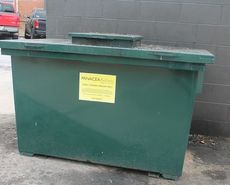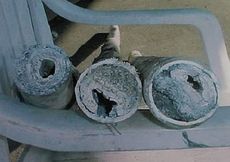
Jim Fair
A collection container for used cooking grease sits near the dumpsters behind BIN112. It is used to make biofuels. Other captured FOG are forwarded to landfills in enclosed containers.

Pipes clogged with fats, oils and grease.
Commissioners on Monday approved a more aggressive Grease Strategy, mostly through an education program for CPW customers. But violators will be fined if residential and commercial customers are unwilling to comply.
CPW customers have benefited, to date, since fees – $10 for residential and $20 for commercial – that have been in place haven’t been assessed and commissioners unanimously approved to rescind that order Monday.
“The fines will be graduated, depending on the circumstances,” CPW General Manager Nick Stegall said. “If it’s a minor violation the fine may be one time. If it’s worse it will be different. We will be targeting repeat offenders.”
Don Milner, from CPW’s wastewater plant, will steer the program. “We’ve stressed that we want to cooperate with people and educate them how to maintain their (FOG),” Stegall said.
CPW has produced a brochure for customers on the proper ways to dispose of grease, dos and don’ts. It details what happens when grease goes down the drain and proper methods for disposing of oil and grease in the home.
Restaurants and food service businesses are recommended to have collection containers to capture oil and grease and CPW suggests food scraps be put in the containers.
A collection container for used cooking grease sits near the dumpsters behind BIN112. It is used to make biofuels. Other captured FOG are forwarded to landfills in enclosed containers.
Owners of restaurants, which have renovated buildings from their original businesses into a food service establishment, will be requested to comply with a collection container. Most restaurants built specifically for the food services have the containers in place.
Requirements for food service establishments and grease haulers to apply for and obtain permits to operate are included in the report.
“We have to pump out one customer about once every three months,” Stegall said. “But we really haven’t enforced the Grease Strategy well in the past.”
The FOG Control Ordinance and Policy contains all the elements of the current Strategy, but with more detailed guidance to aid food service establishments and grease haulers. Included in the provisions is design and structural criteria for grease traps and interceptors and their proper operation and maintenance.
CPW’s report to the commissioners said animal fats and vegetable oils enter the sewer collection system through the kitchen drains of residential and commercial customers. These substances do not mix with water and therefore cause problems in the sewer system, the report said.
FOG enters the sewer in liquid form and then solidifies as cooling of the material takes place. It then sticks to the walls of drains and sewer pipes and blockages eventually occur.
This can result in sewer backups and overflows onto streets and properties, and even inside customers’ homes and businesses. Overflows can adversely impact the environment by contaminating soil, waterways and other items or property it comes into contact with, the report stated.